It looks like you're using an Ad Blocker.
Please white-list or disable AboveTopSecret.com in your ad-blocking tool.
Thank you.
Some features of ATS will be disabled while you continue to use an ad-blocker.
share:
Djade al-Mughara a Neolithic settlement on the Euphrates river north-east of the city of Aleppo. It is a another of the sites near the better known
Gobelki Tepe.
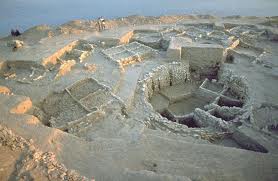
It is best known for a wall picture, the painting would have formed part of the circular wall of a large house. Its red tint came from burnt hematite rock, while crushed limestone formed the white and charcoal provided the black.
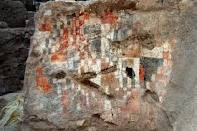
Details of the painting
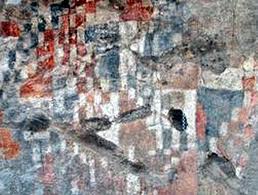
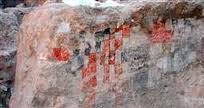
Discussion of the art work
The site has much in common with other sites in this part of the fertile crescent
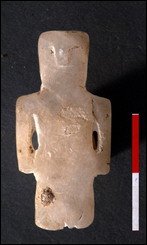
Several burials have also been found
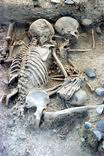
Location of Djade with the other important sites
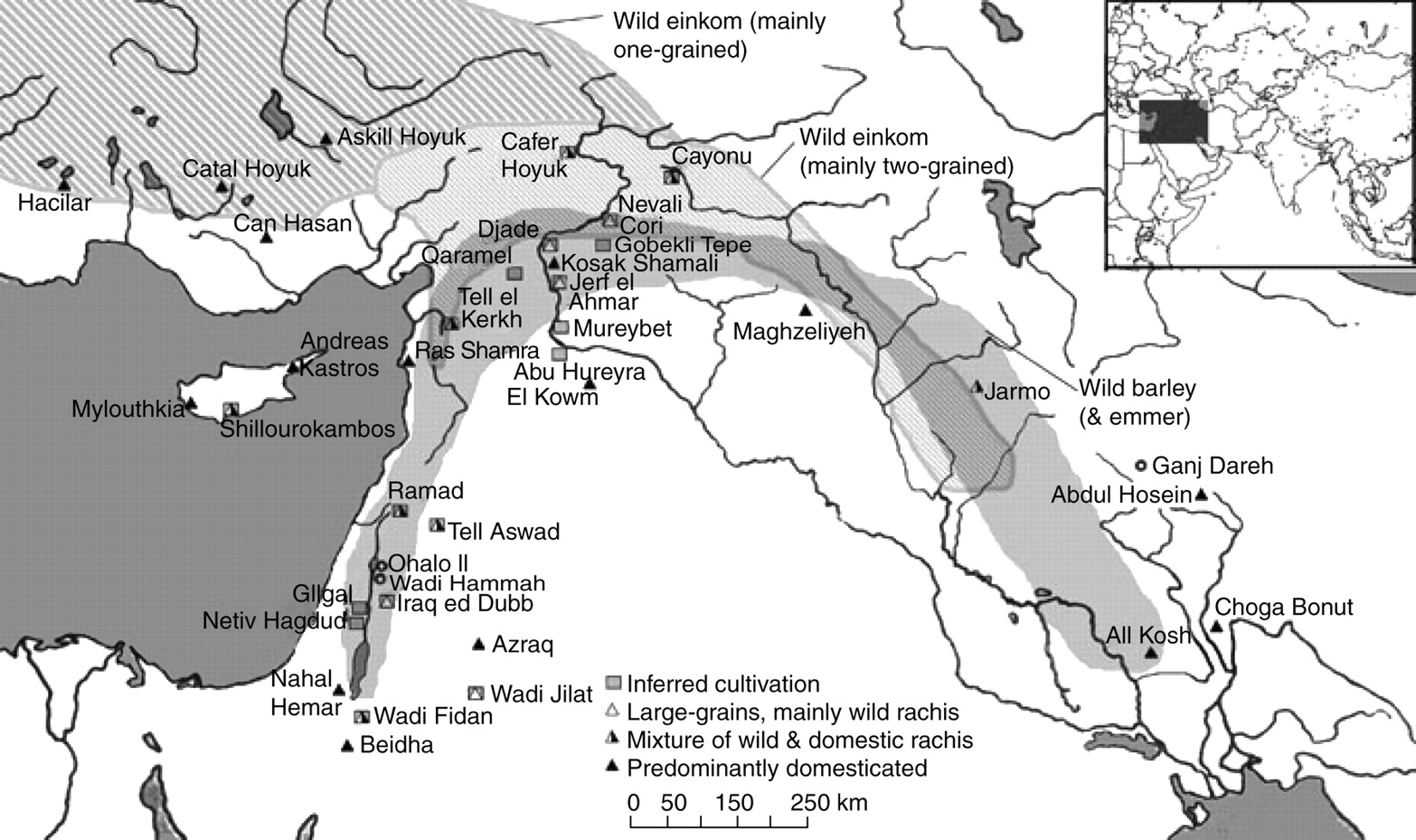

It is best known for a wall picture, the painting would have formed part of the circular wall of a large house. Its red tint came from burnt hematite rock, while crushed limestone formed the white and charcoal provided the black.

Details of the painting


“It looks like a modernist painting. Some of those who saw it have likened it to work by (Paul) Klee. Through carbon dating we established it is from around 9,000 B.C.,” Coqueugniot said
Discussion of the art work
The site has much in common with other sites in this part of the fertile crescent
The inhabitants of Djade al-Mughara lived off hunting and wild plants. They resembled modern day humans in looks but were not farmers or domesticated, Coqueugniot said There was a purpose in having the painting in what looked like a communal house, but we don’t know it. The village was later abandoned and the house stuffed with mud,” he said.

The dig also uncovered several figurines made of gypsum, chalk, bone and clay. The most recent discovery, an 11,000-year-old statue of a man is "particularly important and well preserved," Coqueugniot said.
Several burials have also been found

Location of Djade with the other important sites

edit on 2/3/12 by Hanslune because: Added corrected photo and more details
Beautiful!
That is no "simple" housing either, many different seized and shaped rooms.
I guess storage, kitchen, bed and bathrooms, maybe livestock.
Very sophisticated!
Edit: I would say a monestry or a farm due to the lay out..
That is no "simple" housing either, many different seized and shaped rooms.
I guess storage, kitchen, bed and bathrooms, maybe livestock.
Very sophisticated!
Edit: I would say a monestry or a farm due to the lay out..
edit on 2-3-2012 by EartOccupant because: (no reason given)
reply to post by Hanslune
Nice find op , I find deep interest in the ancient behaviors. Wonder what the painting is of?
Nice find op , I find deep interest in the ancient behaviors. Wonder what the painting is of?
reply to post by EartOccupant
Hey good find, I had the wrong photo up, showing a scene for 5,000 years later but in the same area, corrected above
Hey good find, I had the wrong photo up, showing a scene for 5,000 years later but in the same area, corrected above
edit on 2/3/12 by Hanslune
because: (no reason given)
reply to post by Hanslune
Aha, no problem, this one is also interesting,
for a suppose hunter / gatherer tribe i still find it above expectation in design and whats left visibly.
The star points of the wall facing the river looks like a defense design. Edit: I found a larger version, it looks it is the trench border of the archaeological dig. Oops ;-)
Also the other structures, very nice!
Nice find!
Aha, no problem, this one is also interesting,
for a suppose hunter / gatherer tribe i still find it above expectation in design and whats left visibly.
The star points of the wall facing the river looks like a defense design. Edit: I found a larger version, it looks it is the trench border of the archaeological dig. Oops ;-)
Also the other structures, very nice!
Nice find!
edit on 2-3-2012 by EartOccupant because: (no reason given)
Thrilling. The more I read about this area/era the more I want to know.
Another great, informative thread Hanslune
Another great, informative thread Hanslune
reply to post by Hanslune
Nice op! I love to see new information on the ancients. Especially from that part of the world. Its so strange that alot of the ancient ruins in that area where buried or covered up with sand, etc. I always wonder, was this done purposely or by way of some sort of catastrophic event? Maybe neither. It would only take time for a desert to swallow up a city that was no longer maintained or inhabited. But that raises the question: Why would a civ just up and abandon a city that took so much labor to construct?
The painting is interesting too. Awesome that something painted with charcoal and other minerals could be found in such good condition after 11,000 years. Makes me wanna go paint on some rocks n bury em with sand for another generation to find one day.
S&F
TXML
Nice op! I love to see new information on the ancients. Especially from that part of the world. Its so strange that alot of the ancient ruins in that area where buried or covered up with sand, etc. I always wonder, was this done purposely or by way of some sort of catastrophic event? Maybe neither. It would only take time for a desert to swallow up a city that was no longer maintained or inhabited. But that raises the question: Why would a civ just up and abandon a city that took so much labor to construct?
The painting is interesting too. Awesome that something painted with charcoal and other minerals could be found in such good condition after 11,000 years. Makes me wanna go paint on some rocks n bury em with sand for another generation to find one day.
S&F
TXML
Originally posted by Brayner
reply to post by Hanslune
If i remember corect Gobelki Tepe was also abandon and cover with sand
That was the diggers contention. I find that difficult to conceive and am holding out that the site was abandoned and filled in by natural processes....but further excavation there GT, should give us the answer in 10-15 years
Originally posted by EartOccupant
reply to post by Hanslune
Aha, no problem, this one is also interesting,
for a suppose hunter / gatherer tribe i still find it above expectation in design and whats left visibly.
The star points of the wall facing the river looks like a defense design. Edit: I found a larger version, it looks it is the trench border of the archaeological dig. Oops ;-)
Also the other structures, very nice!
Yeah larger version might be better
edit on 2/3/12 by Hanslune because: (no reason given)
Hanslune
You always have great threads ..I see they found another painting next to it i cant wait to see what that one shows..I see they stated the house was abandoned and stuffed with mud i wonder if that was done to ward off evil spirits ..The wall painting to me is very pretty maybe once they excavate the other painting more will come to light about this place..S&F
You always have great threads ..I see they found another painting next to it i cant wait to see what that one shows..I see they stated the house was abandoned and stuffed with mud i wonder if that was done to ward off evil spirits ..The wall painting to me is very pretty maybe once they excavate the other painting more will come to light about this place..S&F
reply to post by Hanslune
This is a new one to me...thanks for posting it...I wonder is there has been any attempt to trace the source of the haematite. Is there a source local to the region?
Call me a romantic, but it would be rather nice if it came from Lion's Cavern...
s8int.com...
And, it is indeed very reminiscent of Paul Klee.
This is a new one to me...thanks for posting it...I wonder is there has been any attempt to trace the source of the haematite. Is there a source local to the region?
Call me a romantic, but it would be rather nice if it came from Lion's Cavern...
s8int.com...
And, it is indeed very reminiscent of Paul Klee.
:raises hand:
Have a question: with more of these finds of sites dating back so far, is main stream archaeology and anthropology changing how they are looking at things now? I was taught in school that Mesopotamia was the beginnings of humans going from hunter/gathers to agriculture and settlements at about 8,000 years ago. These sites seem to move that back further to as you said 11,000 years ago.
Of course what I was taught in high school was 30 years ago, and I do know that as with any scientific fields, new discoveries sometimes has us change what we thought we knew to something different.
I'm not really a student of ancient cultures and history, all though the subject does interest me quite a bit (I lived in Italy as a teen, and wandering in the ruins of Pompeii and Herculaneum I remember thinking at first: "Just a bunch of old blocks, big deal!" to "Wow, this is SO cool!"), but I'm afraid I spend more of my time reading about astronomy, heh.
Have a question: with more of these finds of sites dating back so far, is main stream archaeology and anthropology changing how they are looking at things now? I was taught in school that Mesopotamia was the beginnings of humans going from hunter/gathers to agriculture and settlements at about 8,000 years ago. These sites seem to move that back further to as you said 11,000 years ago.
Of course what I was taught in high school was 30 years ago, and I do know that as with any scientific fields, new discoveries sometimes has us change what we thought we knew to something different.
I'm not really a student of ancient cultures and history, all though the subject does interest me quite a bit (I lived in Italy as a teen, and wandering in the ruins of Pompeii and Herculaneum I remember thinking at first: "Just a bunch of old blocks, big deal!" to "Wow, this is SO cool!"), but I'm afraid I spend more of my time reading about astronomy, heh.
edit on 2-3-2012 by eriktheawful because: (no reason given)
reply to post by Biliverdin
They may here
Beriwari valley north east of Amadiya perhaps, but I would suspect their were smaller deposits closer.
They may here
Beriwari valley north east of Amadiya perhaps, but I would suspect their were smaller deposits closer.
Originally posted by Hanslune
reply to post by Biliverdin
They may here
Beriwari valley north east of Amadiya perhaps, but I would suspect their were smaller deposits closer.
Cheers However, you would think, that perhaps, had they discovered those sources at that stage, that they would have entered into the iron age before they went through the bronze one...maybe...
reply to post by Biliverdin
Well it took some time to realize you could melt the stuff into metal-and develop the techniques to use it. Smelting iron requires a fairly hot fire and specialized equipment/setup to do it
Well it took some time to realize you could melt the stuff into metal-and develop the techniques to use it. Smelting iron requires a fairly hot fire and specialized equipment/setup to do it
Originally posted by eriktheawful
:raises hand:
Have a question: with more of these finds of sites dating back so far, is main stream archaeology and anthropology changing how they are looking at things now? I was taught in school that Mesopotamia was the beginnings of humans going from hunter/gathers to agriculture and settlements at about 8,000 years ago. These sites seem to move that back further to as you said 11,000 years ago.
Of course what I was taught in high school was 30 years ago, and I do know that as with any scientific fields, new discoveries sometimes has us change what we thought we knew to something different.
I'm not really a student of ancient cultures and history, all though the subject does interest me quite a bit (I lived in Italy as a teen, and wandering in the ruins of Pompeii and Herculaneum I remember thinking at first: "Just a bunch of old blocks, big deal!" to "Wow, this is SO cool!"), but I'm afraid I spend more of my time reading about astronomy, heh.
The information you would have received would have been about 35-40 years old when you got it. Catalhuyuk was excavated in the early 60s but off the top of my head I don't know when they published the early dates. Back then it was probably Jericho (I await Harte, JohnnyCannuck or other notable to correct me on this!).
Yes the dates keep going back. I'll speculate that in time we'll find village lfe going back to 20,000 BP in the middle east
edit on 2/3/12 by
Hanslune because: (no reason given)
Originally posted by Hanslune
reply to post by Biliverdin
Well it took some time to realize you could melt the stuff into metal-and develop the techniques to use it. Smelting iron requires a fairly hot fire and specialized equipment/setup to do it
Well you say that, but bronze making does too, and it also meant travelling thousands of miles to get the tin necessary to get the required result...so as I was saying...
reply to post by Hanslune
Thanks Hanslune for the reply! I think that's really cool to learn.
I remember standing in a street in Pompeii, on these huge stones used in a street intersection that were used as sort of a cross walk, and looking around thinking: wow. This looks like any city in many ways here in Italy.
Later I was in a villa there, in the garden, and though how much it looked like my friend's villa up the coast. I was just amazed at things there.
And I just remembered that it was 30 years ago (awwwwww man, I just made myself feel old and sad!
)
Still glad I can remember it though!
Okay, going back to reading more. Thanks for the thread, very interesting.
Thanks Hanslune for the reply! I think that's really cool to learn.
I remember standing in a street in Pompeii, on these huge stones used in a street intersection that were used as sort of a cross walk, and looking around thinking: wow. This looks like any city in many ways here in Italy.
Later I was in a villa there, in the garden, and though how much it looked like my friend's villa up the coast. I was just amazed at things there.
And I just remembered that it was 30 years ago (awwwwww man, I just made myself feel old and sad!
)
Still glad I can remember it though!
Okay, going back to reading more. Thanks for the thread, very interesting.
Originally posted by Biliverdin
Well you say that, but bronze making does too, and it also meant travelling thousands of miles to get the tin necessary to get the required result...so as I was saying...
Copper is easier to melt that iron and doesn't require carbon infusions to make it 'better'
Tin
Afghanistan now emerges as the most promising eastern source of tin, with western sources most likely located in southern England, Brittany and Tuscany. Central European tin sources still provide serious problems within the context of the nature of Bronze Age mining technology and the type of cassiterite being utilized at that time.
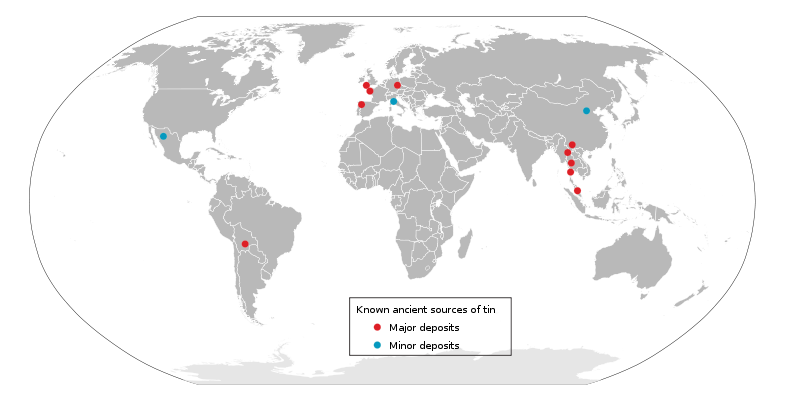
You'll note this image doesn't show the source in Afghanistan
new topics
-
Claim: General Mark Milley Approved Heat and Sound Directed Energy Weapons During 2020 Riots
Whistle Blowers and Leaked Documents: 1 hours ago
top topics
-
Claim: General Mark Milley Approved Heat and Sound Directed Energy Weapons During 2020 Riots
Whistle Blowers and Leaked Documents: 1 hours ago, 1 flags
active topics
-
Claim: General Mark Milley Approved Heat and Sound Directed Energy Weapons During 2020 Riots
Whistle Blowers and Leaked Documents • 5 • : fringeofthefringe -
Gravitic Propulsion--What IF the US and China Really Have it?
General Conspiracies • 24 • : mysterioustranger -
Sorry to disappoint you but...
US Political Madness • 34 • : Kaiju666 -
Joe Biden gives the USA's Highest Civilian Honor Award to Hillary Clinton and George Soros.
US Political Madness • 59 • : mysterioustranger -
Greatest thing you ever got, or bought?
General Chit Chat • 24 • : mysterioustranger -
Post A Funny (T&C Friendly) Pic Part IV: The LOL awakens!
General Chit Chat • 7998 • : underpass61 -
The Truth about Migrant Crime in Britain.
Social Issues and Civil Unrest • 20 • : bastion -
Biden to award Presidential Citizens Medal to Liz Cheney and Bennie Thompson
US Political Madness • 20 • : xuenchen -
Judge rules president-elect Donald Trump must be sentenced in 'hush money' trial
US Political Madness • 39 • : xuenchen -
January 6th report shows disturbing trend (nobody is shocked)
US Political Madness • 60 • : fringeofthefringe
